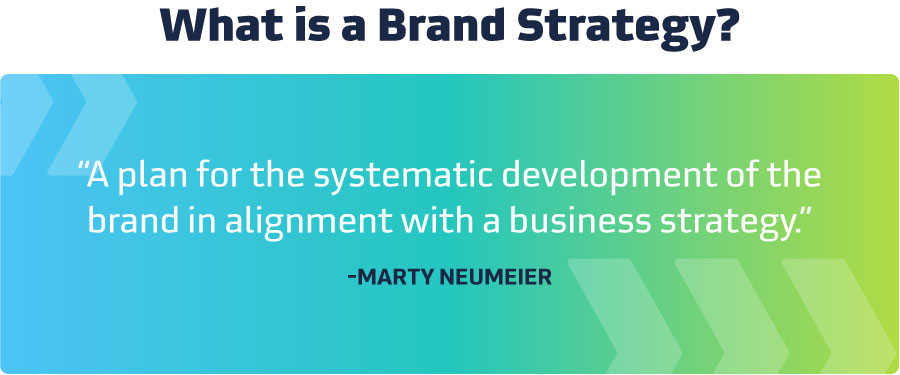Creating a Strong Brand: Our Step-by-step Guide
 Krista
|
Krista
|

Even the most successful entrepreneurs admit that creating a strong brand can be challenging. It requires that you intimately understand your target audience, their needs, and what you have to offer to solve their problems. Perhaps more importantly, you must know your company and what it is trying to accomplish. Only then can you create messaging communicating these things to your potential customers.
We see it repeatedly: people come to us wanting help with their marketing and communications but need help articulating who they are and what they're trying to achieve. It's common for growing businesses. We've heard, "We didn't know our brand as well as we thought we did," more than once. Brand strategy can be challenging for businesses, but with our guidance, it can be. Our step-by-step brand creation guide will help you attain healthy business growth.
Benefits of a Strong Brand Strategy
When you think about branding, you may want to jump straight to a flashy logo and color scheme for your packaging. We encourage you to slow down and start with the basics. When you set aside the time to create a brand strategy, you will better understand who you are as a business. You can use your beliefs and values to guide your decisions in better methods for your employees, business, and future.
You'll be able to communicate your brand and its values consistently and effectively through every piece of content and marketing collateral you make. You'll be able to attract the right customers you want to build a strong and lasting brand. And you'll be able to position your brand in a way that gives you a competitive advantage now and in the future.
Brand Strategy: A Step-by-step Guide
As branding guru Marty Neumeier says, a brand strategy is "a plan for the systematic development of the brand in alignment with a business strategy." In the simplest terms possible, it's a plan for your brand that works with your plan for your business to achieve growth, market share, and whatever your goals may be.

Several components comprise your brand strategies, such as your tone when communicating with your target market and the principles guiding your business. The all-encompassing approach helps consumers associate a company with quality and trust. Voice, narrative, brand identity, brand values, and brand mood are just a few factors that make up a brand strategy.
If your brand is your company's public face, then your branding strategy is the framework upon which that face rests.
In the coming paragraphs, we'll cover the steps to understand when developing your brand strategy through brand positioning.
Step 1: Establish Your Brand's Core
Four elements encompass your brand's core: vision, mission, promise, and commitments. Each of these may be as short as one line or as long as several paragraphs, but each deserves careful consideration. Let's cover them and how they contribute to business growth.
Vision
The concepts that lie at the heart of a brand and serve to direct its path into the future refer to as the brand's vision. A brand's "vision" is a concise statement that articulates the driving force for the company's existence.
Mission
Your brand's mission communicates its purpose. The reason for why you exist and how you want to serve your audience. This is a remark that often indicates how you are going to improve the lives of the people in your audience. You want to balance realism and optimism that illustrates your value to your customers and why people should want to work for you. It should be both specific and plausible.
Promise
The value of experiences your consumers anticipate receiving from your business each time they connect with the brand is known as the brand promise. It is what people do to accomplish their goals and fulfill their mission.
Commitments
Brand commitment is what your company and its brand are committed to accomplishing to meet the vision, mission, and promise. It is how you assure your consumers will succeed in their endeavors.
Step 2: Identify Your Target Customers
Who are the people you want to do business with? And don't say, everyone. Companies with great growth and high profits strongly emphasize having precisely defined target customers. Your growth will come faster if you concentrate your efforts.
Your target audience is the exact set of potential customers most likely to desire your product or service. As a result, they are the individuals who see your advertising efforts. Many different characteristics, including but not limited to age, gender, income, geography, and hobbies, may be used to determine a target audience. Target audiences may be split further into groups pertaining to intent, geography, interests, and other factors.
Time spent researching data from consumer encounters, assessing existing purchasers and purchasing habits, and adjusting to new information is essential for identifying your target demographic.
The steps below should help you identify your ideal customers:
Examine Your Clientele and Conduct In-depth Interviews to Learn More About Them
One of the finest methods to identify your ideal customers is to determine who already purchases your product or service. What are their ages, hometowns, and favorite pastimes? Participating in social media or sending out client surveys are also effective methods of discovering this information.
Find Market Opportunities and Analyze Market Trends
Check out the stats for your sector to see if there are any service gaps your product can address. Examine the market for comparable items to discover where the competition is emphasizing.
Examine the Level of Competition
Competitor analysis may teach marketers much about their target audience and their methods to reach them. What kinds of methods, online and off, do they employ? Which key player do they see as crucial to their success?
Build Your Personas
Developing user personas is an effective strategy for narrowing down on critical subsets of your target audience. If your product has broad appeal, this will be extremely useful. You may learn about your ideal customer's demographics, personalities, and demands by creating "personas" of them. The personas have different needs "Owner Oscar" and "Sam reseller" Marketers build personas to help them better understand their target audience by drawing on data, surveys, and digital interactions. Include things like preferred pastimes, programs, magazines, etc. The ideal number of personas for a marketing team to create is three to five.
Establish Who You Are Not Trying to Reach
Consumers that are on the cusp of your ideal audience but don't convert are inevitable. Be as precise as possible when identifying your target audience. Do most of your customers specifically identify as female or as females aged 20–40? This knowledge will prevent your teams from wasting advertising resources on unprofitable demographics.
Keep Up-to-date
Your knowledge of your audience niches will improve as you collect more data and engage with more clients. This data suggests continuous optimization and fine-tuning of personas is essential for optimal performance.
Implement Analytics
You may learn a lot about who is visiting your site with the help of analytics tools like Google Analytics. To make better-informed choices throughout the media planning process, you can use this data to learn where your target audience is coming from and what content they find most interesting and engaging.
Step 3: Articulate Your Messaging
Once you have established your brand's core and target audience, you can create a clear framework for your brand messaging.
Brand Essence (Personality, Voice, Tone)
The essence of a brand serves as a bedrock to ensure that the brand always comes across as genuine and reliable. It articulates a company's values and goals to its target audience and helps build its overall identity. It is usually just two or three words long.
Brand essence, like personality, cannot be imitated. When a company or product isn't being authentic, it loses credibility in the eyes of consumers and risks losing their allegiance. Because of this, businesses often utilize brand essence as a benchmark for all future branding initiatives, such as logo creation and social media content selection.
Value Propositions
A value proposition briefly explains why consumers should buy your goods or services. It expresses most plainly the value that clients get from working with you. Every value proposition should address a problem faced by a consumer and argue that your business is the best option for solving that issue.
While a strong value proposition may highlight your unique selling points compared to the competition, it must always maintain sight of how the end user perceives value. Similar to how discussions of brand strategy and taglines should begin with a value proposition, these elements are different.
Customer Story
Your customer story comprises your target audience's pain points, challenges, concerns, budget, and more. Some of this may come from your customer personas or product development. After all, you created your business to solve a problem or fill a gap in a market. The customer story is a useful place to keep this information together so everyone in your company thoroughly understands who they serve.
Messaging Pillars
Brand messaging pillars are the foundation of a successful brand's communication. Your brand's communications hierarchy should start with these pillars, a condensed version of your core values. Although seemingly effortless, this is only sometimes the case. Whether you're just starting with a new business or your brand has been operating for years with an ever-expanding offer, reflecting on your company's vision and mission may help you choose your brand's pillars.
Step 4: Build Your Visual Systems
Now that you have your brand messaging all figured out, you can start to develop your visual systems. Robust visual systems are flexible, comprehensive, and intuitive. If your system is flexible, it should be able to grow with your brand, whether you're branching out into new products, services, or new industries. If it's comprehensive, it should provide brand designers and content creators with the tools they need to do their jobs properly. And if it's intuitive, it should be well-constructed so that each element complements the other instead of competing.
The visual systems for a brand typically include a logo, color palette, typography, imagery style, iconography, and illustrations. The logo is a brand's iconic symbol, representing it over any single product. Imagine the seashell of Shell, the golden arches of McDonald's, or the bitten apple of Apple computers. The other items should be determined and consistent, whether your brand's illustrations should be perky and colorful or edgy and exciting.
Step 5: Develop Communication Strategies
Your final step is developing business growth strategies that translate your brand positioning into messages to your target audiences. You must quickly satisfy your burning subconscious question when choosing between products or perhaps trying something new. "What's in it for me?"
Of course, what that answer is depends on your product or service. For example, if you are a logistics company, your communication to prospective customers might highlight how your services save time and money and make their lives easier.
You Can Create a Strong Brand Successfully Using This Guide
You can bring your brand to life with these steps. When you establish your brand's core, identify your target customers, articulate your messaging, build your visual systems, and develop messaging strategies, you will have a foundation as solid as the bedrock for a consistent and flexible brand that will grow with your business.
We're Here to Help
Still feeling adrift? TANK New Media is poised to help! Schedule a time to meet with our team. We'll cover where you're currently with your brand and uncover the opportunities you have to grow your brand. Contact us today!
Subscribe to Our Blog
Stay up to date with the latest marketing, sales, and service tips.



